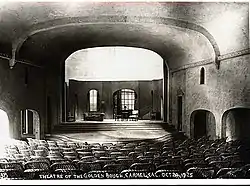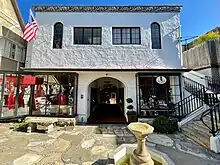Theatre of the Golden Bough
The Theatre of the Golden Bough was located on Ocean Avenue in Carmel-by-the-Sea, California. This "Golden Bough" was one of two theaters in Carmel's history. It was destroyed by fire on May 19, 1935. Kuster moved his film operation to the older facility on Monte Verde Street, renamed it the Filmarte and it became the first "art house" between Los Angeles and San Francisco. It later became the Golden Bough Playhouse that still exists today.[1]
 Theatre of the Golden Bough, 1925 | |
| Address | Ocean Avenue |
|---|---|
| Location | Carmel-by-the-Sea, California, U.S. |
| Coordinates | 36°33′6.61″N 121°55′27.95″W |
| Owner | Pacific Repertory Theatre |
| Type | Regional theatre |
| Capacity | 297 |
| Construction | |
| Built | 1922-1923 |
| Architect | Edward G. Kuster |
| Builder | Lee Gottfried |
History
The theatre was designed and built by Edward G. Kuster in 1922. It was located on the southeast corner of Ocean Avenue between Lincoln Street and Monte Verde Street, with The Court of the Golden Bough in front.[2] He hired Lee Gottfried to build it. Kuster was a musician and lawyer from Los Angeles who relocated to Carmel to establish his own theatre and school. Kuster's wife built the Carmel Weavers Studio, with a ticket booth in front of the Golden Bough theatre.[3]
During 1928, an additional floor was built for the Golden Bough, designed by architect Guy O. Koepp, to house a new restaurant. The building featured large arched casement windows on the north and west sides, offering views of the ocean. A fireplace was also incorporated into the west wall, while vaulted ceilings with exposed wooden surfaces were added to enhance its appearance.[4]
In 1928, the Abalone League, a local amateur baseball club and active thespian group, bought the Carmel Arts and Crafts Hall from the Carmel Arts and Crafts Club and renamed it the Abalone Theatre, and later that year Kuster leased the Theatre of the Golden Bough on Ocean Avenue to a local movie exhibitor, the Manzanita Theatre. Kuster then traveled to Europe for one year to study production techniques in Berlin and to negotiate for rights to produce English and European plays in the United States. In 1929, after returning from his European trip, Kuster leased the Theatre of the Golden Bough to a movie theater chain for a period of five years. Kuster stipulated that the name "Golden Bough" could not be used for a movie house so it was renamed the Carmel Theatre.[5]
Theatre fire

In 1935, Kuster renegotiated his lease with the movie tenants of the Theatre of the Golden Bough, to perform a stage play one weekend each month. On May 17, 1935, Kuster opened his production of the play By Candlelight. Two nights later, on May 19, the original Theatre of the Golden Bough was destroyed by fire. Arson was the suspected cause of the blaze.
Kuster, who had previously bought out the Arts and Crafts Theatre, moved his film operation to the older facility on Monte Verde Street, renamed it the Filmarte and it became the first "art house" between Los Angeles and San Francisco. It later became the Golden Bough Playhouse.[1]
Golden Bough Court

In February 1950, a section of the former Theatre of the Golden Bough, which once surrounded the wood door entrance near Ocean Avenue of the Golden Bough Theater, was sold by Kuster to Sumral and Ruth Otrich. This slice of land, measuring 47 ft (14 m) by 80 ft (24 m), is situated directly behind the present-day Cottage of Sweets (formerly known as the Carmel Weavers Studio) in the Golden Bough Court. Upon acquiring the land, Otrich invested $50,000 (equivalent to $608,160 in 2022) to construct three English Tudor-style shops and three apartments on a second floor.[6][7] The Otrich building in the Court has been designed by Charles Simons of Architect Robert Jone's office.[8]
The design of this development was in harmony with the overall architecture of the area. Concurrently, Anita Doud, brother of real estate developer James Doud, owned the property that housed the restaurant called Sade's (now Portabella). Anita Doud intended to expand Sade's and construct a building for shops and apartments that would complement Otrich's development. Additionally, E. M. and Helen C. Beecher purchased property facing Monte Verde.[7]
Today, these buildings are part of the Golden Bough Court, where only the facade of the original Theatre building remains. The Theatre entrance now opens to an arcade courtyard featuring various shops.[6][7]
References
- "Back Again, Intriguing history of Carmel's Golden Bough Theatre", Alta Vista Magazine/Monterey County Herald, August 28, 1994
- "Golden Bough Theatre (290 Seats)". Pacific Repertory Theatre. Carmel-by-the-Sea, California. Retrieved 2023-07-16.
- Flower, Richard (2014). "Edward Kuster and The Threepenny Opera". Stories of old Carmel: A Centennial Tribute From The Carmel Residents Association. pp. 105–106. OCLC 940565140.
{{cite book}}:|work=ignored (help)CS1 maint: location missing publisher (link) - "Will Sell The Tableware As Well As The Viands". Carmel Pine Cone. Carmel-by-the-Sea, California. 1928-05-11. p. 5. Retrieved 2023-05-14.
- Temple, Sydney (1987). Carmel By-The-Sea: From Aborigines to Coastal Commission. Angel Press. pp. 137–154. ISBN 0-912216-32-8.
- Dramov, Alissandra (2022). Past & Present Carmel-By-The-Sea. Charleston, South Carolina: Arcadia Publishing. pp. 44–45. ISBN 9781467108980. Retrieved 2023-03-08.
- "Plan Shopping Center for Golden Bough Site". Carmel Spectator. Carmel-by-the-Sea, California. February 2, 1950. p. 9. Retrieved 2023-08-01.
- "The Golden Bough Court". Carmel Spectator. Carmel-by-the-Sea, California. June 6, 1950. p. 12. Retrieved 2023-08-01.